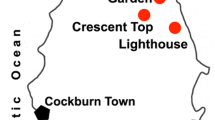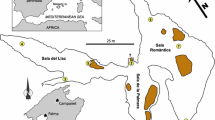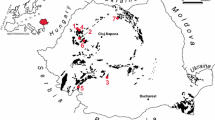Abstract
Radon concentration and gamma activity concentration of naturally occurring radionuclides were determined and presented for two tourist caves (Karaca and Çal caves) in this study. These caves are reported to receive about 77,000 visitors during the summer season in 2007. It was seen that mean radon activity concentrations for the winter and summer seasons for the Karaca cave is 1,023 and 823 Bq/m3 and for the Çal cave is 264 and 473 Bq/m3. Mean 226Ra, 232Th, and 40K activity concentrations are found to be 43, 19, and 262 Bq/kg for the Karaca cave and 31, 27, and 460 Bq/kg for the Çal cave. Doses received by the cave guides due to radon were estimated to be 2.9 mSv/year for the winter season and 2.3 mSv/year for the summer season for the Karaca cave. Same values were estimated for the Çal cave, and the results were found to be 0.6 mSv/year for the winter season and 1.1 mSv/year for the summer season. Annual effective doses received by the visitors in both caves were estimated to be in the order of μSv/year because of the short exposure time comparing the cave guides. Although the reported values are below the recommended values, both groups are exposed to possible radiological risk during their stay inside the cave, since prolonged exposure to high radon concentration has been linked to lung cancer.



Similar content being viewed by others
References
Duenas, C., Fernandez, M. C., Canete, S., Carretero, J., & Liger, E. (1999). 222Rn concentrations, natural flow rate and the radiation exposure levels in the Nerja Cave. Atmospheric Environment, 33, 501–510.
Espinosa, G., Golzarri, J. I., Gammage, R. B., Sajo-Bohus, L., Viccon-Pale, J., & Signoret-Poillon, M. (2008). Seasonal variation measurements of radon levels in caves using SSNTD method. Radiation Measurements, 43, 364–368.
European Communities (EC). (1990). Commission Recommendation 90/143/EUROATOM of 21 February 1990 on the protection of the public against indoor exposure to radon. Off J, L-80, 26–28.
Eyüboğlu, Y., Bektas, O., Şeren, A., Maden, N., Ozer, R., & Jacoby, W. R. (2006). Three directional extensional deformation and formation of the Liassic rift basins in the Eastern Pontides (NE Turkey). Geologica Carpathica, 57, 337–346.
Faulkner, K., and Gillmore, G. K. (1995). Geology and radon entry into buildings. In the radon manual, Second edition; A guide to the requirements for the detection and measurement of natural radon levels, associated remedial measures and subsequent monitoring of results. The Radon Council Ltd. Sheppteron, Middlesex.
Gillmore, G. K., Sperrin, M., Phillps, P., & Denman, A. (2000). Radon hazards, geology, and exposure of cave users: A case study and some theoretical perspectives. Ecotoxicology and Environmental Safety, 46(3), 279–288.
Gillmore, G. K., Phillips, P. S., Denman, A. R., & Gilbertson, D. D. (2002). Radon in the Creswell Crags Permian limestone caves. Journal of Environmental Radioactivity, 62, 165–179.
International Commission on Radiation Protection. (1994). Protection against radon-222 at home and at work. ICRP Publication, 651994. Oxford: Pergamon.
Korkmaz, S. (1993). Stratigraphy of the Tonya-Düzköy (SW Trabzon) area, NE Turkey. Geological Bulletin of Turkey, 36, 151–158.
Lario, J., Sanchez-Moral, S., Canaveras, J. C., Cuezva, S., & Soler, V. (2005). Radon continuous monitoring in Altamira Cave (northern Spain) to assess user's annual effective dose. Journal of Environmental Radioactivity, 80, 161–174.
Sainz, C., Quindos, L. S., Fuente, I., Nicolas, J., & Quindos, L. (2007). Analysis of the main factors affecting the evaluation of the radon dose in workplaces: The case of tourist caves. Journal of Hazardous Materials, 145, 368–371.
United Nations Scientific Committee on the Effects of Atomic Radiation (UNSCEAR) (2000). Annex B: Exposure from natural radiation sources.
Acknowledgements
This work was supported by Karadeniz Technical University under the project 2007.111.001.3. The authors are thankful to Mr. Serdar Keskin for giving useful information about the geology of the caves.
Author information
Authors and Affiliations
Corresponding author
Rights and permissions
About this article
Cite this article
Cevik, U., Kara, A., Celik, N. et al. Radon Survey and Exposure Assessment in Karaca and Çal Caves, Turkey. Water Air Soil Pollut 214, 461–469 (2011). https://doi.org/10.1007/s11270-010-0437-6
Received:
Accepted:
Published:
Issue Date:
DOI: https://doi.org/10.1007/s11270-010-0437-6




